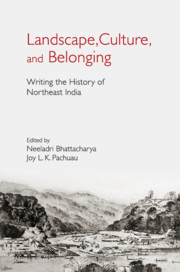Book contents
- Frontmatter
- Contents
- List of Figures
- Acknowledgements
- Introduction
- I Borders and Beyond
- II Surveys and Explorations
- 4 Picturing a Region: A Geographical History of British Assam
- 5 Geographical Exploration and Historical Investigation: John Peter Wade in Assam
- III Ethnography, History, and the Politics of Representation
- IV Law, State, and Practices of Governance
- V Cultural Dialogues
- Notes on Contributors
- Index
4 - Picturing a Region: A Geographical History of British Assam
from II - Surveys and Explorations
Published online by Cambridge University Press: 26 April 2019
- Frontmatter
- Contents
- List of Figures
- Acknowledgements
- Introduction
- I Borders and Beyond
- II Surveys and Explorations
- 4 Picturing a Region: A Geographical History of British Assam
- 5 Geographical Exploration and Historical Investigation: John Peter Wade in Assam
- III Ethnography, History, and the Politics of Representation
- IV Law, State, and Practices of Governance
- V Cultural Dialogues
- Notes on Contributors
- Index
Summary
Introduction
India's Northeast frontier remains invisible in many ‘India studies’. Its peculiar ‘geo-ethnic character’ often makes its location uneasy within pan-Indian discourses, and disturbs the notion of a defining essence of Indianness. In fact, this ‘cultural area’ is at the margin of three firmly located geographical regions as well as academic ‘study areas’ – South Asia, Southeast Asia, and East Asia. Modern national maps know no better way of accommodating such an overlapping zone than by rendering it ‘remote’ from the core zone in ways that erase the region from public consciousness. Those who live in the lowlands may view the sub-Himalayan area as a barrier dividing riverain communities in India and China. In the eyes of mountain dwellers, mountain crests appear rather like bridges, not necessarily barriers. ‘It has received peoples and cultures,’ as Kirk has remarked, ‘from many directions, at various times, but has imposed on them its own peculiar regime born of the unity of high places.… This is one of the earth's greatest highland zones, nourishing its own complexities of race and culture, and exhibiting its own internal environmental contrasts.’
Objectifying the ‘Geo-body’ of British Assam
The writing of Northeast India's regional history is caught between two equally problematic frames: one characterized by regionalist insularity and the other by nationalist superficiality. Shrinking from a grueling trek into the hills, national historiographies and historical surveys of South Asia sometimes leave the Northeast – a perceived periphery – off the map. Another extreme tendency is to swing too far towards Northeastern exceptionalism in search of a shared sectional unity under the British colonial regime. Special historical studies that are produced within the region remain remarkably insular in a positivist vein, and their dense factuality hardly relates to wider historical problems. An engagement with ‘geographical history’ – especially an enquiry into divergent cartographic cultures – provides a corrective to the prevalent view of a static Northeast existing in a ‘splendid isolation’. This entails a defense of the region or section as a unit of historical analysis in order to appreciate the play of local forces – not necessarily secessionism – that often escapes the attention of nationalist historiography.
- Type
- Chapter
- Information
- Landscape, Culture, and BelongingWriting the History of Northeast India, pp. 89 - 109Publisher: Cambridge University PressPrint publication year: 2019



